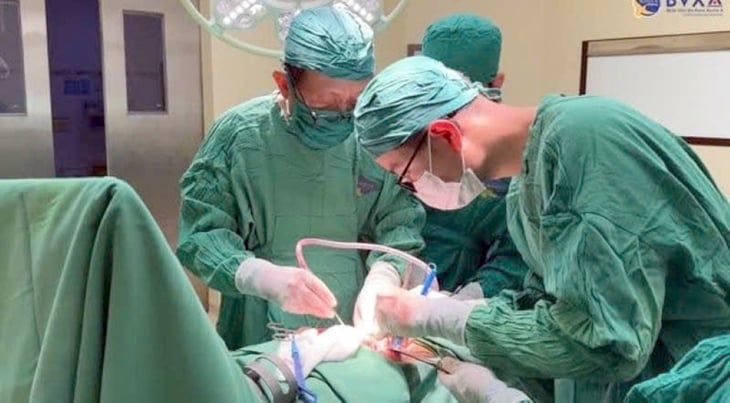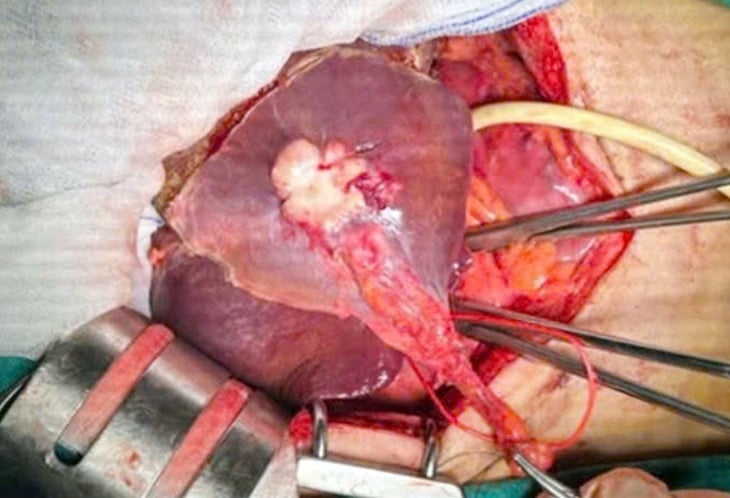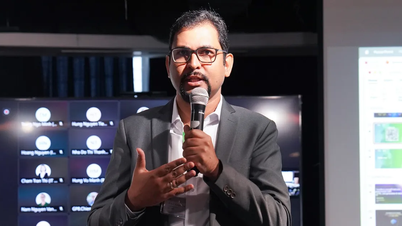
Surgery to remove stones and resect liver lobes for a patient - Photo: BVCC
Many people suddenly have to have their livers removed or develop bile duct cancer because they subjectively think their gallstones are benign and are not checked. Small gallstones that many people often ignore can sometimes be the seed of another disease.
This is not only a dangerous disease but also a major challenge in medicine due to the difficulty in early diagnosis and complex treatment.
Unpredictable danger
A 69-year-old male patient with a history of gallbladder surgery five years ago was admitted to Bach Mai Hospital ( Hanoi ) with symptoms of dull epigastric pain, yellow sclera, and weight loss of 3 kg within a month. Examination results: biliary obstruction due to gallstones, suspected bile duct cancer, left liver abscess...
Surgery showed that the intraoperative lesion was an invasive tumor, a stone located in the lower part of the OMC about 1cm in size, causing obstruction of bile flow, the bile flowed out cloudy. There were many lymph nodes in the hilum of the pancreas.
Postoperative pathology revealed adenocarcinoma of the biliary tract - an uncommon, indolent but extremely malignant cancer.
Similarly, Ms. HTKH (47 years old, former Soc Trang ) had recurring abdominal pain. She went to the Xuyen A General Hospital in Vinh Long and discovered that stones were filling the common bile duct and left liver, causing her to have left liver cirrhosis. Surgery was performed to remove many small stones that had gathered into clusters measuring 14 x 8mm, while cutting the left lobe of the liver and placing a drain into the bile duct... promptly preventing the risk.
Dr. Le Quoc Toan, Department of General Surgery, Xuyen A General Hospital, Vinh Long, said that in the case of patient H., if the part of the liver containing the stones is not treated, the risk of recurrence of gallstones after treatment is very high, the patient is susceptible to recurrent acute cholangitis, and at the same time, this part of the liver with cirrhosis has a very high risk of intrahepatic bile duct cancer.
Therefore, liver resection is the best solution for this case.

Image of HPT IV liver tumor during surgery and tumor after surgery - Photo: BVCC
Difficult to diagnose early
Dr. Nguyen Thanh Khiem, digestive surgery center, Bach Mai Hospital, warns about small gallstones that many people often ignore. But gallstones are not simply a benign disease but are "inflammatories" and become "cancer-causing" gallstones.
The development of cancer on the background of bile duct stones can be explained by several mechanisms: bile duct stones are the condition of deposition of substances in bile to form stones.
Initially, gallstones may only cause abdominal cramps, fever, and jaundice due to obstruction or inflammation. However, if gallstones persist for a long time and cause chronic inflammation, the risk of developing bile duct cancer will increase significantly.
Biliary tract cancer is a major medical challenge due to the difficulty in early diagnosis and complex treatment. People with gallstones should have regular check-ups if they have a history of gallstones and pay special attention to signs of jaundice and yellow eyes. This is a symptom when the tumor causes obstruction of the bile duct.
Jaundice usually appears gradually, unlike jaundice from gallstones, which is often accompanied by abdominal pain and fever. Itching all over the body due to accumulation of bilirubin in the blood. Pale stools and dark urine are the result of bile obstruction.
Pain in the right lower quadrant or epigastric region that can be dull or severe and continuous. Unexplained weight loss accompanied by fatigue and loss of appetite. Prolonged low-grade fever due to infection or cancer.
Do not wait until the stones become complicated before treating them.
Dr. Dang Quoc Ai, deputy head of the general surgery department at E Hospital, said that gallstones are a common disease in Vietnam, and can occur in anyone, but are less common in young people. People at high risk include: obese people because gallstones are related to excess cholesterol in the blood; women using birth control pills containing estrogen...
Gallstones can cause other complications such as peritonitis, acute pancreatitis, biliary septic shock...
These are all urgent surgical emergencies that can be life-threatening. In addition, gallstones are the cause of chronic inflammation, which over time will lead to gallbladder atrophy, stasis cholecystitis, and is the origin of dysplasia and cancer of the gallbladder and bile ducts.
Dr. Truong Thanh Tung, deputy head of the Department of Urology at Thanh Hoa General Hospital, said that small, mobile common bile duct stones often have no clinical manifestations and can only be discovered by chance during a systematic examination or sometimes manifest as mild, transient pain in the right subcostal region.
When common bile duct stones cause typical biliary obstruction and biliary tract infection, the general condition changes very quickly such as fever, fatigue, loss of appetite, yellow skin and mucous membranes, increasing weight and rapid weight loss... When severe biliary tract inflammation causes life-threatening syndromes such as hepatorenal syndrome (liver failure, cirrhosis, ascites, cholestasis, subcutaneous hemorrhage), kidney failure...
How to prevent disease
People should have regular health check-ups every year, especially if gallstones are detected, they should have a check-up every six months, and should take early and proactive intervention. Currently, there are many methods to diagnose and detect common bile duct stones early, such as ultrasound, abdominal CT scan, endoscopic retrograde cholangiopancreatography (ERCP), magnetic resonance cholangiopancreatography (MRCP)...
Early detection through regular health check-ups will help the treatment process be more effective and safer.
How is surgery to remove stones?
Dr. Thanh Tung recommends that if gallstones are detected early, treatment is relatively simple, such as surgery to remove the stones or drain the bile duct. If the stones persist for a long time and gradually develop, they will lead to cirrhosis, ascites, and cholestasis. Therefore, if there are symptoms such as abdominal cramps, severe pain, jaundice, yellow eyes, etc., the patient needs to go to a medical facility immediately for timely treatment.
Dr. Dang Quoc Ai warned that in the past, when medicine was not yet developed, gallbladder surgery was a last resort because the surgery was extremely difficult, so many people still held the view that gallstones should only be treated when complications arose. But today, that view is no longer appropriate.
We are living in an era of disease prevention, early detection, early treatment and handling of disease causes, not letting the disease progress to a serious stage, causing difficulty in treatment, affecting health, and endangering life.
Source: https://tuoitre.vn/bat-ngo-xo-teo-gan-do-soi-mat-20250808080645261.htm






























































































Comment (0)